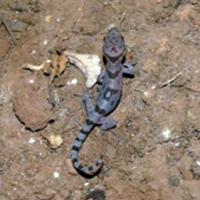Ecological characteristics of a recently described, critically endangered gecko species, endemic to Central Highland, Vietnam

All claims expressed in this article are solely those of the authors and do not necessarily represent those of their affiliated organizations, or those of the publisher, the editors and the reviewers. Any product that may be evaluated in this article or claim that may be made by its manufacturer is not guaranteed or endorsed by the publisher.
Accepted: 2 September 2020
Authors
Gia Lai bent-toed gecko (Cyrtodactylus gialaiensis) was firstly described in 2017, and is an endemic species with very restricted distributional range, estimated to be less than 10 km2 in coffee plantation in Gia Lai province, Central Highland of Vietnam. This species is listed as Critically Endangered (CR) in the IUCN Red List. To date, the natural history of this species is totally unknown. In this paper, we provide the first-of-ever natural history data on this highly threatened gecko species, with emphasis on morphometrics, habitat preferences, thermal ecology, and activity patterns. In 23 days of surveys, we captured 42 C. gialaiensis individuals and recaptured 4 of them. Sex ratio was not skewed from equality and juveniles accounted for 23.8% of the observed individuals. The two sexes did not differ in terms of mean Snout-to-Vent Length, Tail Length and weight, but the adult females had longer head than adult males. Geckos were observed at a mean substratum temperature of 24.2±1°C (n=14), and exhibited a mean body temperature of 29.5±2.5°C (n=14). There was no significant correlation between substratum and body temperatures. Body temperatures were significantly higher than substratum temperatures. The study species exhibited a clearly nocturnal above-ground activity, with main peak occurring between 20:00-21:30 h.
How to Cite
PAGEPress has chosen to apply the Creative Commons Attribution NonCommercial 4.0 International License (CC BY-NC 4.0) to all manuscripts to be published.







